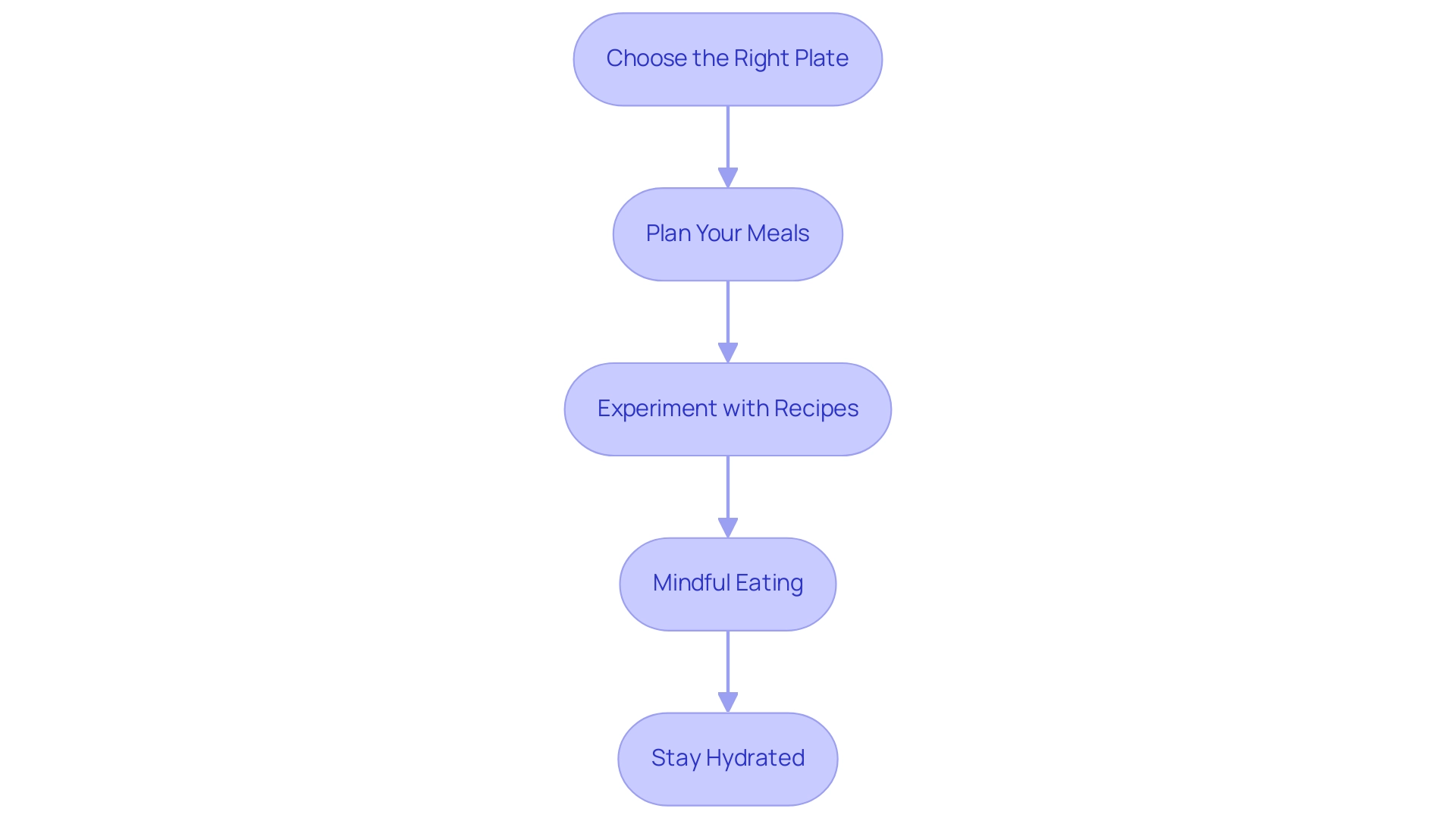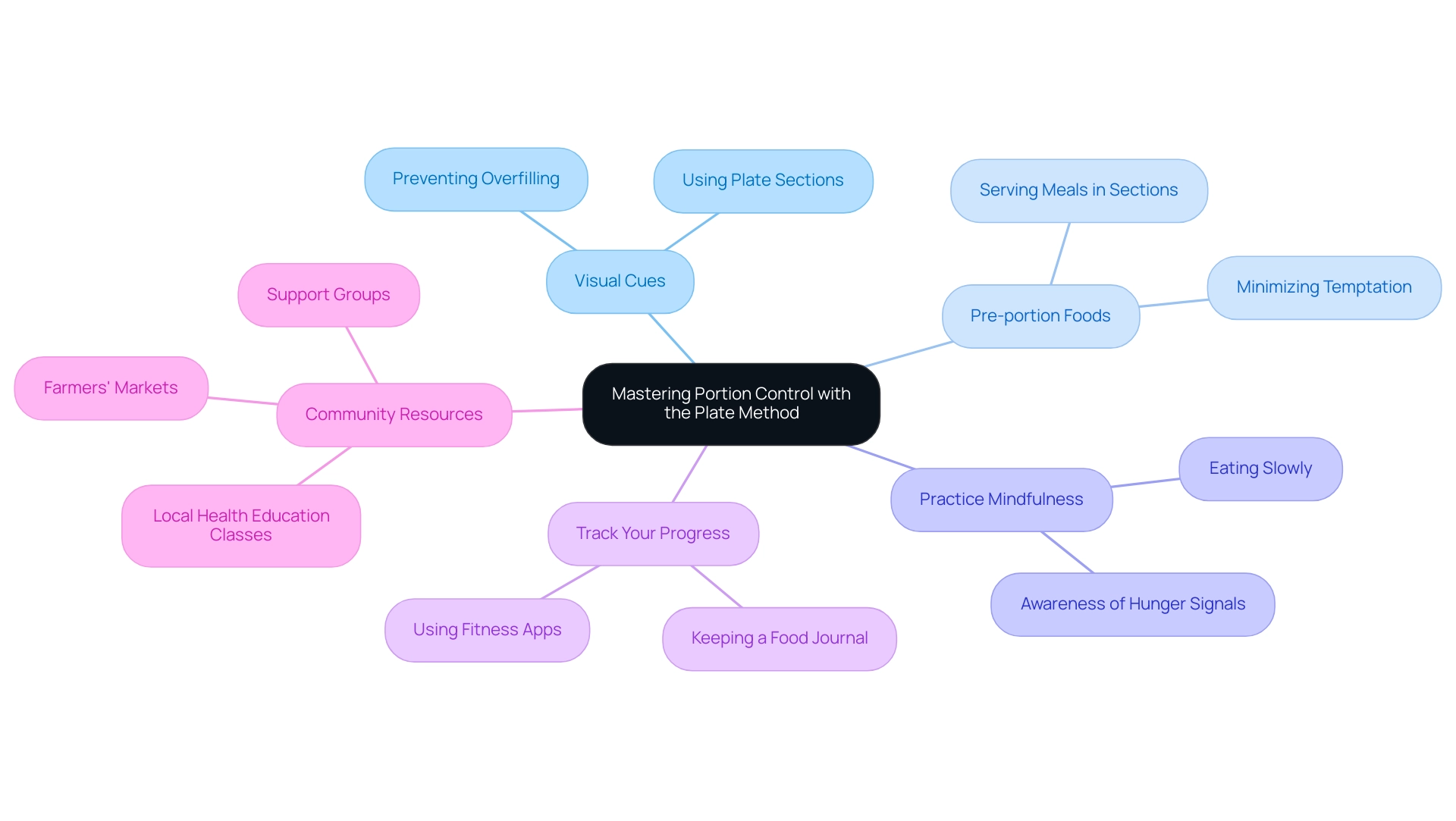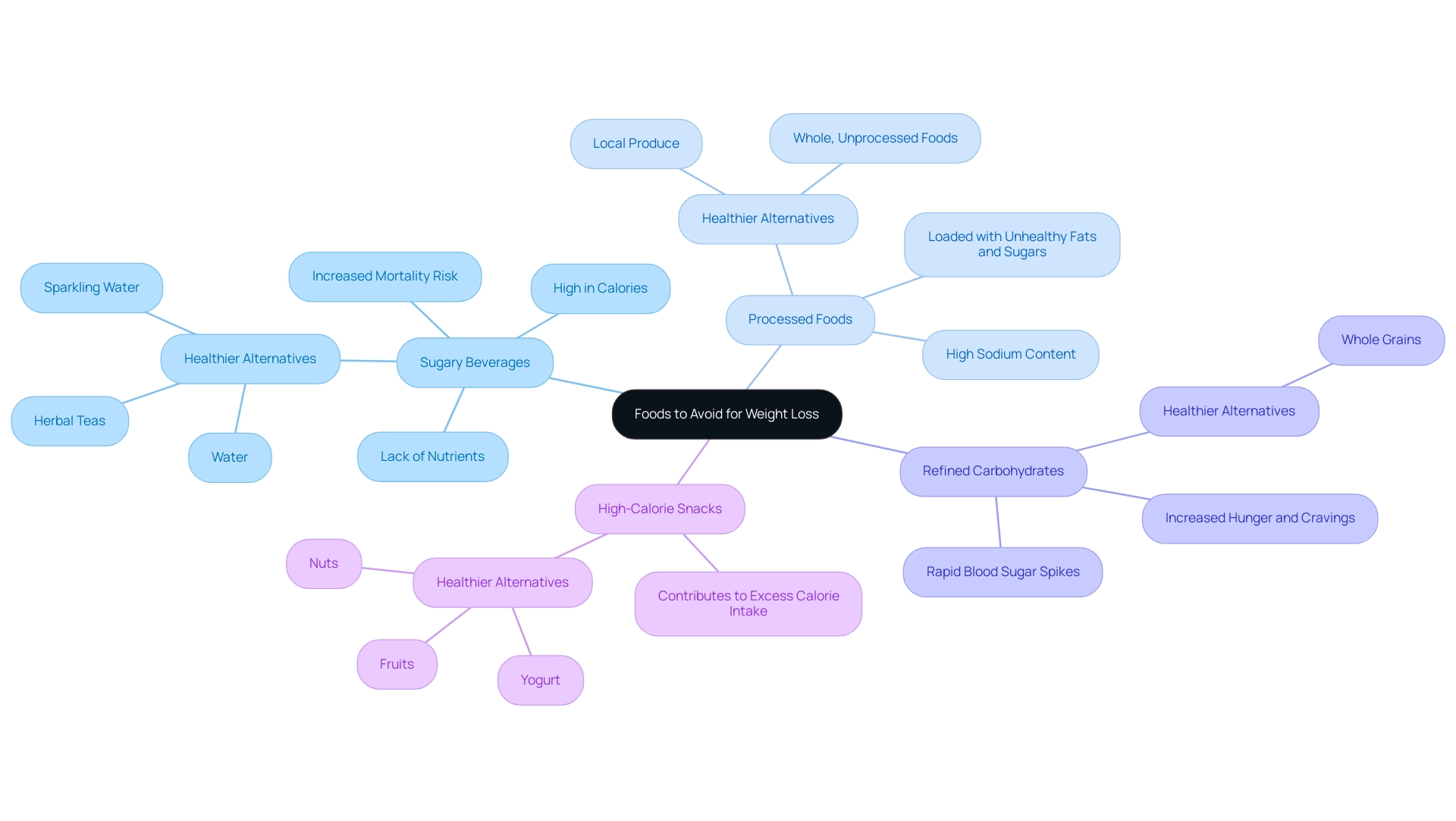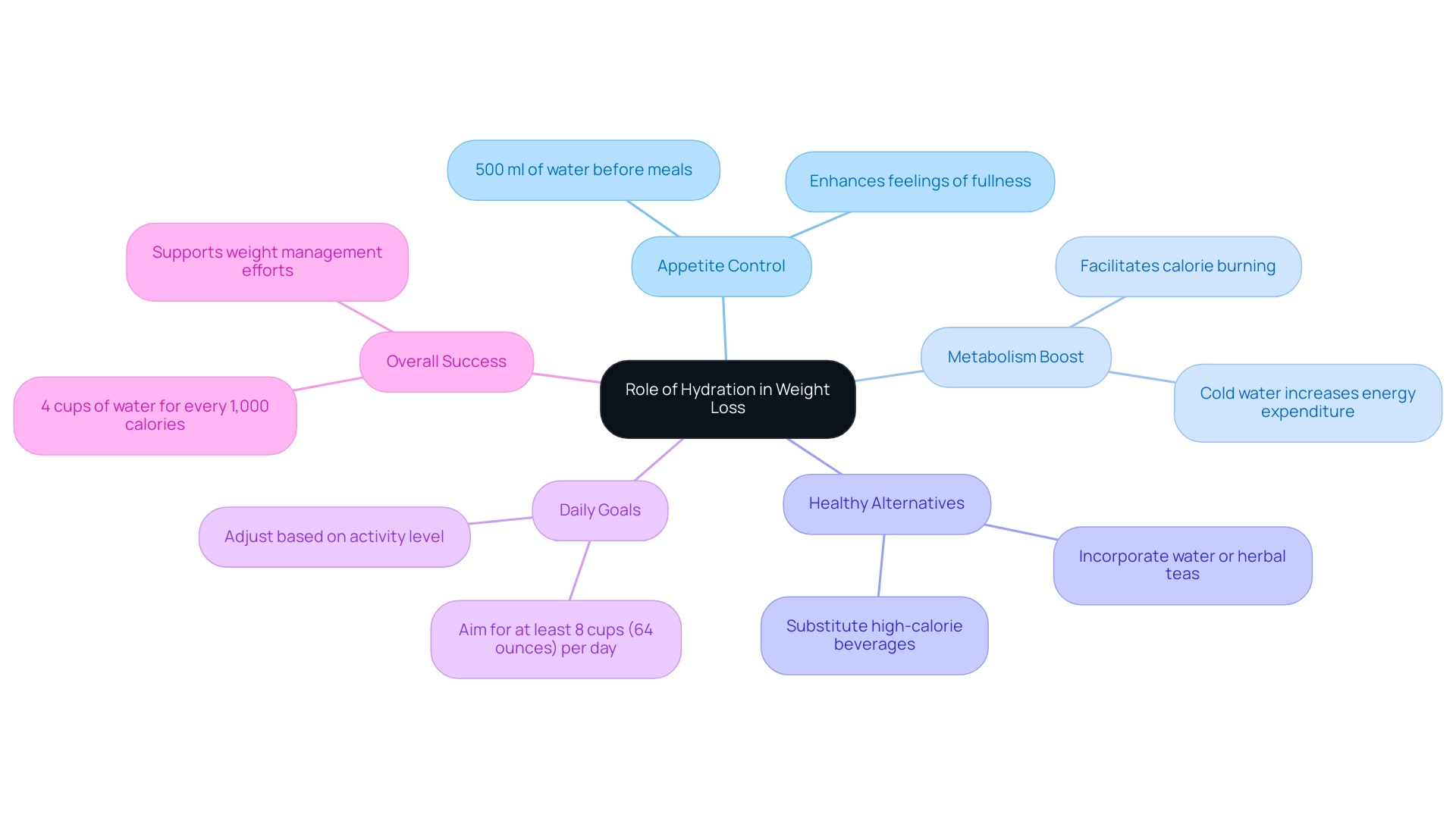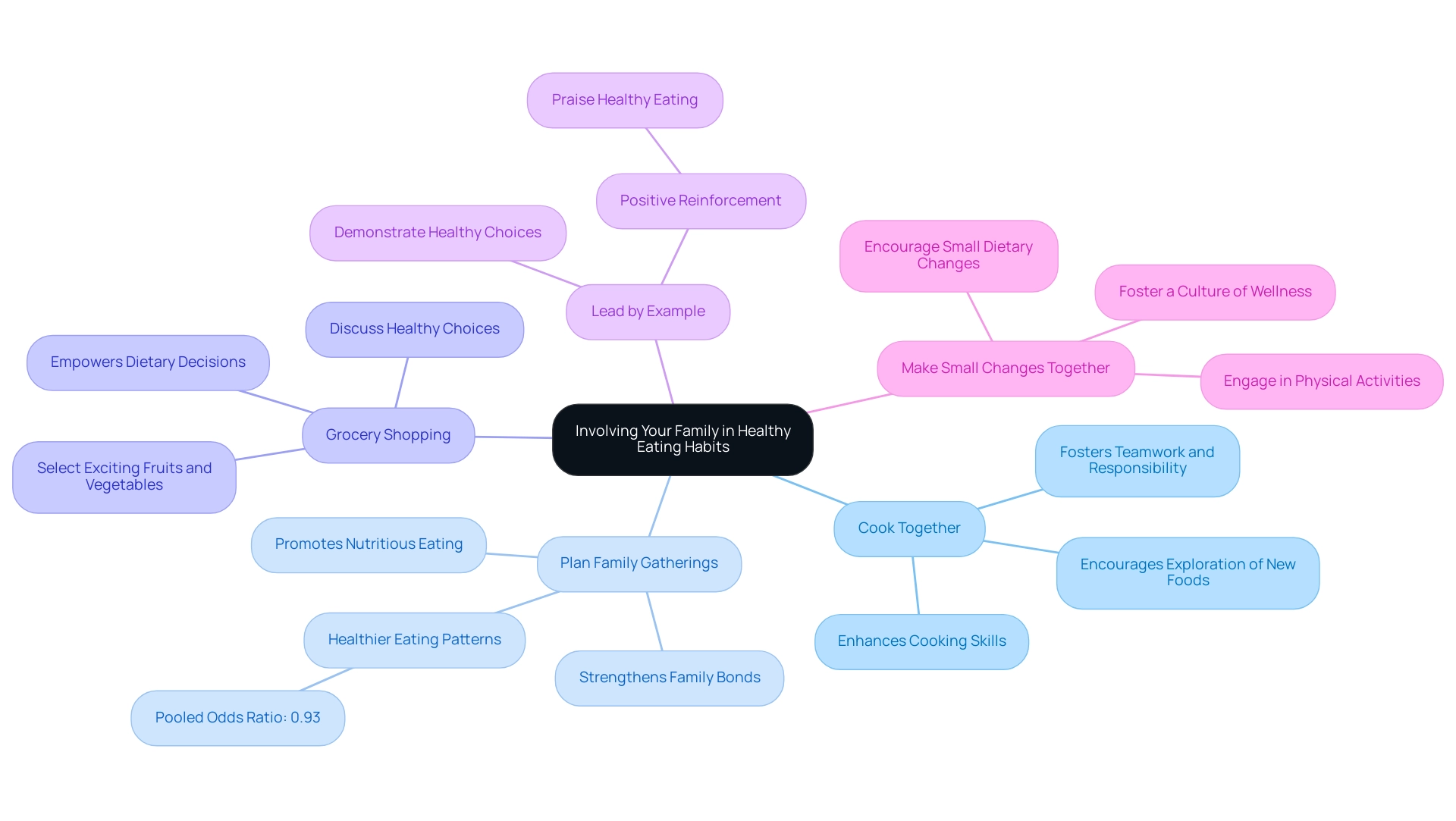Overview
The Plate Method for weight loss offers a compassionate approach to achieving balanced meals, especially for those navigating the challenges of managing type 2 diabetes. By visually dividing a plate into sections for non-starchy vegetables, lean proteins, and healthy carbohydrates, this method not only aids in portion control but also promotes overall health management. It’s important to recognize that many individuals struggle with maintaining a healthy diet, and this structured strategy can provide a sense of clarity and direction.
Research has shown significant weight loss results and improved dietary habits among those who embrace this method. Many patients find that having a clear visual guide helps them make healthier choices, fostering a nurturing environment for their wellness journey. This approach is particularly beneficial for individuals managing type 2 diabetes, as it encourages mindful eating and balanced nutrition.
If you’re feeling overwhelmed by dietary changes, remember that you’re not alone. The Plate Method can serve as a supportive tool, guiding you toward healthier living. By incorporating this strategy into your daily routine, you can take meaningful steps toward your health goals, fostering a sense of empowerment and control over your choices.
Introduction
In a world where dietary choices can feel overwhelming, have you ever found yourself searching for a simple yet effective way to manage your health? The Plate Method emerges as a beacon of simplicity, particularly for those navigating the challenges of type 2 diabetes.
By visually dividing a standard dinner plate into sections for:
- Vegetables
- Lean proteins
- Healthy carbohydrates
this method not only streamlines meal preparation but also encourages healthier eating habits. Many patients find that adopting this straightforward approach can lead to significant weight loss and improved health outcomes.
It’s important to recognize that this tool can be invaluable for anyone looking to take control of their nutrition. As you embark on your health journey, the Plate Method offers a practical solution that aligns with holistic wellness principles, empowering you to make mindful choices and reclaim your well-being.
Understanding the Plate Method: An Overview
The plate method for weight loss is a compassionate visual strategy designed to help you manage food portions and create balanced meals, simplifying the process without the need for complex calculations. This method divides a standard dinner plate into distinct sections: half for non-starchy vegetables, one-quarter for lean protein, and the remaining quarter for healthy carbohydrates. This straightforward yet impactful approach not only supports weight loss but also promotes overall health by encouraging the consumption of nutrient-dense foods, aligning beautifully with the integrative strategies at Dr. Jason Shumard‘s Integrative Wellness Center, which emphasizes functional medicine.
It’s important to recognize that research shows using smaller plates can significantly help prevent overeating, a crucial aspect for those managing type 2 diabetes. A systematic review of portion-controlled plates found that participants experienced notable reductions in body mass, body mass index (BMI), and waist circumference. Specifically, weight reductions ranged from 1.01 to 3.03 kg over three months and 0.62 to 2.69 kg over six months, highlighting the effectiveness of this method in real-life scenarios and its relevance to blood sugar management.
For individuals navigating diabetes management, the plate method for weight loss offers a structured way to control calorie intake while ensuring a balanced diet. By visually segmenting the plate, you can easily incorporate a variety of food groups, which is essential for maintaining stable blood sugar levels. Many patients find that this method fosters healthier eating habits, with numerous practitioners advocating for its use as a foundational tool in dietary interventions, similar to the personalized nutrition plans developed at the Integrative Wellness Center.
Patients at the Integrative Wellness Center have shared their positive experiences with the plate method for weight loss, noting improvements in their ability to manage portions and make healthier food choices. One patient expressed, “Since starting the Plate Method, I’ve regained control over my eating habits, and my blood sugar levels have stabilized.” This sentiment aligns with Dr. Shumard’s commitment to empowering individuals through actionable insights and practical tools, enabling them to reclaim their wellness and well-being.
As Dr. Jason Shumard states, “By providing patients with actionable insights and practical tools, the center cultivates an environment where individuals can regain their wellness and well-being.” The plate method for weight loss not only assists in shedding pounds but also enhances the overall quality of life for those managing blood sugar issues, making it a valuable strategy in the journey toward better health, as reflected in transformative patient testimonials from the center’s 30-Day Reset program.
To explore how the Plate Method can assist you in managing your diabetes, we invite you to reach out to the Integrative Wellness Center today at 858-564-7081.
Essential Components of a Healthy Plate
Creating a healthy plate can feel overwhelming, but focusing on a few key components can make all the difference:
- Non-Starchy Vegetables: Aim to fill half your plate with a vibrant array of non-starchy vegetables, such as leafy greens, broccoli, carrots, and bell peppers. These vegetables are not only low in calories but also rich in fiber, promoting satiety and helping you manage your body composition effectively. Many individuals find that including more non-starchy vegetables in their diet greatly improves their overall well-being and assists in shedding excess pounds. It’s worth noting that from 2011 to 2018, non-Hispanic whites experienced a significant decrease in their HEI-2015 score, underscoring the importance of dietary changes in improving health outcomes.
- Lean Proteins: Dedicate one-quarter of your plate to lean protein sources like chicken, turkey, fish, tofu, or legumes. These proteins are crucial for muscle maintenance and help you feel full longer. Experts emphasize that adequate protein intake is essential for managing body composition, as it can help reduce cravings and prevent overeating.
- Healthy Carbohydrates: The final quarter of your plate should consist of healthy carbohydrates, including whole grains like brown rice or quinoa, and starchy vegetables such as sweet potatoes. These foods provide necessary energy and vital nutrients, contributing to a balanced diet that aids in managing blood sugar levels.
Incorporating these components into your meals not only supports weight loss but also aligns with the plate method for managing type 2 diabetes. Dr. Jason Shumard emphasizes a holistic approach to personalized nutrition counseling, helping individuals effectively integrate these healthy choices into their daily routines. As Dr. Shumard states, “By providing patients with actionable insights and practical tools, the center fosters an environment where individuals can reclaim their wellness and well-being.”
Transformative patient experiences, like those shared by individuals who participated in Dr. Shumard’s 30-Day Diabetes Reset program, demonstrate that adopting the plate method for weight loss has led to notable enhancements in their wellness and overall quality of life. This highlights the transformative power of mindful eating.
Moreover, the functional medicine approach at Integrative Wellness Center offers safe and effective solutions for chronic illnesses, addressing the root causes of medical issues rather than merely treating symptoms. This approach is particularly crucial, especially in light of alarming statistics, such as 7,000 incorrect medications given to patients in hospitals and 80,000 infections acquired by patients in hospitals. If you’re ready to explore how Dr. Shumard can help you restore your health and reclaim your life, please call 858-564-7081 or register now to discover the full story.
How to Implement the Plate Method in Daily Meals
To effectively implement the Plate Method in your daily meals while managing type 2 diabetes in San Marcos, CA, consider the following steps:
-
Choose the Right Plate: Opt for a 9-inch plate to help manage portion sizes. Using a smaller plate can create the illusion of larger servings, enhancing your satisfaction with food.
-
Plan Your Meals: Prior to mealtime, visualize how you will divide your plate. Aim for a balanced distribution: half of your plate should consist of vegetables, one-quarter should be protein, and the remaining quarter should be carbohydrates. This planning can be incorporated into your food preparation routine or grocery shopping list. Allocating one day a week for food preparation can save time in the long term by minimizing daily cooking and cleaning. Consider incorporating fresh, local produce from San Marcos farmers’ markets, such as avocados and leafy greens, to enhance your dishes.
-
Experiment with Recipes: Explore new recipes that fit the Plate Method. For instance, prepare a colorful stir-fry featuring a variety of vegetables, lean chicken, and brown rice, ensuring that your plate reflects the recommended proportions. Utilizing seasonal ingredients from local markets can make your dishes both nutritious and enjoyable.
-
Mindful Eating: During meals, concentrate on your food. Chew slowly and savor each bite, which can help you become more attuned to your body’s signals of fullness. Engaging in mindful eating practices can also be complemented by stress management techniques available in the community, such as yoga or meditation, which are essential for overall well-being.
-
Stay Hydrated: Hydration plays a crucial role in managing blood sugar levels. Opt for water or herbal teas instead of sugary drinks to help maintain proper hydration without impacting blood sugar levels. Explore local options like infused water or natural, no-sugar-added beverages to support your health.
Implementing the Plate Method not only aids in portion control but also supports weight loss efforts, particularly for those managing type 2 diabetes. Research indicates that effective food planning can significantly enhance fat loss success, with structured approaches leading to better adherence to dietary goals. Additionally, a survey highlighted that 71% of Americans experienced weight gain during the pandemic, underscoring the importance of strategies like the Plate Method in overcoming challenges related to healthy eating.
As Modell states, “Food preparation and making the decision to consume balanced dishes allows for flexibility while also encouraging you to eat items that make you feel good mentally and physically.” By adopting these steps and leveraging local resources, including restaurants that cater to diabetes-friendly diets, you can create a sustainable and enjoyable approach to planning that promotes overall health and well-being. For personalized guidance and support tailored to your unique needs, consider reaching out to Dr. Jason Shumard in San Marcos, CA.
Our expert team is dedicated to helping you navigate your diabetes management journey with care and expertise.
Mastering Portion Control with the Plate Method
To effectively master portion control with the Plate Method, it’s important to consider implementing some thoughtful strategies that can truly make a difference:
- Visual Cues: Think of your plate as a guide. By utilizing the designated sections of your plate as visual indicators for portion sizes, you can simplify food preparation while preventing the common pitfall of overfilling your plate. This small change promotes healthier eating habits and helps you feel more in control.
- Pre-portion Foods: Serving meals by pre-portioning food into specific sections of your plate, rather than using communal dishes, can significantly minimize the temptation to take additional servings. This simple approach supports better portion control and helps you stay on track with your goals.
- Practice Mindfulness: It’s essential to cultivate awareness of your hunger signals. Eating slowly and stopping when you feel satisfied—rather than full—can enhance your understanding of your body’s needs. Many find that mindful eating not only aids in weight loss but also enhances overall well-being, making it a valuable practice, especially for those managing diabetes.
- Track Your Progress: Keeping a food journal to monitor your intake and portion sizes can be incredibly insightful. This practice helps you identify eating patterns and make necessary adjustments, reinforcing your commitment to healthier choices. Utilizing fitness apps or journals can further enhance your tracking efforts, aligning with the SMART goal-setting approach that emphasizes specific, measurable, attainable, relevant, and time-bound objectives.
Incorporating these strategies can significantly enhance your ability to manage portion sizes effectively, which is crucial when applying the Plate Method for weight loss. This leads to improved outcomes and a more balanced approach to eating. A study on the effectiveness of educational tools for portion size awareness has shown that such interventions can improve self-reported strategies for controlling portion sizes. However, individual counseling did not significantly impact the hypothesized outcomes. As Dr. Jason Shumard highlights, “By offering patients actionable insights and practical tools, the Integrative Wellness Center creates a setting where individuals can regain their wellness and well-being.”
Moreover, participating in community wellness initiatives in San Marcos, such as local health education classes and support groups, can offer invaluable resources tailored to your unique needs while promoting a sense of connection with others on similar health journeys. Additionally, exploring local farmers’ markets can enhance your diet with fresh produce, supporting your health management efforts.
Foods to Avoid: Enhancing Your Weight Loss Journey
To optimize your weight loss journey, especially while managing type 2 diabetes, it’s important to recognize the foods that may hinder your progress. Let’s explore some of these together:
- Sugary Beverages: Beverages like soda, sweetened teas, and energy drinks are often high in calories and lack essential nutrients. In fact, sugary beverages represented 62% of children’s beverage sales in 2018, underscoring a concerning trend that contributes to obesity and can significantly impact management for individuals with type 2 diabetes. Instead, consider hydrating with water, herbal teas, or sparkling water, which can keep you refreshed without the extra calories.
- Processed Foods: Many processed foods are loaded with unhealthy fats, sugars, and sodium, which can undermine your weight loss efforts. By focusing on whole, unprocessed foods, you can improve your wellness outcomes and achieve more effective weight management through the plate method for weight loss. Dr. Jason Shumard emphasizes the importance of a balanced diet rich in local produce, which supports overall well-being and helps manage blood sugar levels.
- Refined Carbohydrates: Foods such as white bread, pastries, and sugary cereals can lead to rapid spikes in blood sugar, increasing hunger and cravings. Opting for whole grains can help stabilize blood sugar and promote satiety, aligning with Dr. Shumard’s holistic approach to nutrition.
- High-Calorie Snacks: Snacks like chips, cookies, and candy can significantly contribute to excess calorie intake. Instead, consider healthier alternatives such as fruits, nuts, or yogurt, which provide essential nutrients and help keep you satisfied. Many patients find that engaging with community wellness programs in San Marcos offers support and resources tailored to managing diabetes while enjoying the beautiful surroundings.
Research has shown a clear link between high sugary beverage consumption and increased mortality risk, particularly from cardiovascular diseases. A study titled “Mortality Risk Associated with Sugary Drinks” indicates that higher sugary beverage consumption correlates with an increased risk of premature death. By decreasing sugary beverage consumption, you can improve your body mass management and enhance your overall well-being and lifespan.
Real-life instances of successful reduction often highlight the advantages of the plate method for weight loss, illustrating how conscious dietary selections can lead to substantial improvements in wellness and quality of life. As Dr. Jason Shumard states, “By providing patients with actionable insights and practical tools, the Integrative Wellness Center fosters an environment where individuals can reclaim their health and well-being.” For personalized guidance tailored to your unique needs, consider reaching out to Dr. Shumard at the Integrative Wellness Center in San Diego.
Our expert team is dedicated to helping you navigate your diabetes management journey with care and expertise. Additionally, addressing the need for policy actions to reduce soft drink consumption is crucial in combating obesity and promoting healthier dietary choices.
The Role of Hydration in Weight Loss
Hydration is a fundamental component of effective weight management strategies, particularly for those navigating the complexities of type 2 diabetes. It’s important to recognize that small changes can make a significant difference in your journey. Here are several critical aspects to consider:
-
Appetite Control: Have you ever noticed how drinking water before a meal can enhance feelings of fullness? This simple act can lead to reduced food intake, making it easier to manage your weight.
Studies suggest that consuming around 500 ml of water before meals can assist individuals in feeling full, which is especially advantageous for managing body mass. Aim to drink a glass of water about 30 minutes before eating to maximize this effect.
-
Metabolism Boost: Staying well-hydrated is essential for maintaining an efficient metabolism. Many patients find that adequate hydration can facilitate calorie burning. Interestingly, studies suggest that cold water may be particularly effective, as your body expends energy to warm it to body temperature. This metabolic enhancement can support your fat loss efforts, aligning beautifully with Dr. Jason Shumard’s holistic strategies for managing type 2 health conditions at the Integrative Wellness Center.
-
Healthy Alternatives: Have you considered substituting high-calorie beverages with water or herbal teas? This straightforward change can significantly decrease overall calorie consumption, aiding your weight loss objectives without the need for complex dietary alterations. Dr. Shumard emphasizes the importance of nutrition in managing diabetes, making this an essential strategy.
-
Daily Goals: Establishing a daily hydration target is crucial. Aim for at least 8 cups (64 ounces) of water each day, adjusting this amount based on your activity level and environmental conditions. Higher water consumption has been associated with improved weight loss results, with studies indicating that participants who increased their water intake lost around 2 kg more over 12 weeks than those who did not. The water group also reported a higher daily water consumption, contributing to significant changes in body composition and clinical characteristics.
Role of Hydration in Weight Loss Success: The significance of hydration goes beyond simply quenching thirst; it plays a crucial role in appetite control and overall weight loss success. As a rule of thumb, try to consume about four cups of water for every 1,000 calories you eat to help maintain optimal hydration levels, further supporting your weight management efforts.
Incorporating these hydration strategies into your daily routine can empower you to take control of your health and enhance your weight loss journey. By focusing on hydration alongside other lifestyle changes, such as balanced nutrition and regular exercise, you can effectively manage your type 2 diabetes and improve your overall well-being.
For personalized guidance and support tailored to your unique needs, consider reaching out to Dr. Shumard at the Integrative Wellness Center. Our expert team is dedicated to helping you navigate your diabetes management journey with care and expertise.
Involving Your Family in Healthy Eating Habits
To effectively involve your family in adopting healthy eating habits, consider implementing these nurturing strategies:
- Cook Together: Involve your family members in food preparation. This collaborative effort not only teaches essential cooking skills but also encourages everyone to explore and enjoy new foods together. Many families find that cooking together significantly enhances their dietary habits, fostering a sense of teamwork and shared responsibility for health.
- Plan Family Gatherings: Establish a routine of regular family gatherings where everyone can partake in healthy dishes. This practice not only promotes nutritious eating but also strengthens family bonds through shared experiences. Research shows that families who dine together tend to have healthier eating patterns, with a pooled odds ratio of 0.93 for reduced overweight prevalence among those who share meals regularly.
- Grocery Shopping: Involve your family in grocery shopping trips and discuss the importance of making healthy choices. Encourage them to select fruits and vegetables they are excited to try. This not only educates them about nutrition but also empowers them to take an active role in their dietary decisions.
- Lead by Example: Demonstrate healthy eating behaviors in your daily life. When family members observe you making nutritious choices, they are more likely to emulate those habits. Positive reinforcement, such as praising healthy eating, can significantly influence dietary behaviors within the family context. As Christopher D. Pfledderer pointed out, enhancing dietary practices in families can lead to significant wellness advantages.
- Make Small Changes Together: Encourage your family to make small dietary changes and engage in physical activities together. This approach not only enhances individual well-being but also fosters a culture of wellness within the family unit. The case study titled ‘Need for Family-Focused Wellness Interventions’ highlights the necessity for interventions aimed at improving dietary habits within families, particularly those with a history of medical issues.
By incorporating these strategies, families can create a supportive environment that fosters healthy eating habits, ultimately benefiting everyone involved. Engaging in these practices not only enhances individual health but also cultivates a culture of wellness within the family unit.
Additional Resources and Tips for Success
To effectively support your loss journey using the Plate Method, consider these valuable resources and strategies:
- Books and Guides: Delve into literature on the Plate Method and healthy eating. Dr. Shumard’s insightful publications, rated 5.0 out of 5 stars, offer comprehensive guidance and practical advice. These resources empower you with the knowledge needed to make informed dietary choices.
- Online Communities: Engage with online forums or social media groups dedicated to healthy eating and weight loss. These platforms foster a sense of community where you can share experiences, exchange tips, and find motivation from others on similar journeys.
- Cooking Classes: Participate in local cooking classes that emphasize healthy meal preparation. These classes not only enhance your culinary skills but also introduce you to nutritious recipes that align with the Plate Method for weight loss, making healthy eating enjoyable and sustainable.
- Consult a Professional: Collaborate with a registered dietitian or nutritionist who can offer personalized guidance tailored to your unique health needs. Their expertise can help you navigate the complexities of dietary changes and ensure you are on the right path toward achieving your loss goals.
- 30-Day Diabetes Reset Program: Consider enrolling in Dr. Jason Shumard’s groundbreaking, clinically validated 30-Day Diabetes Reset program at Integrative Wellness Center. This program has been instrumental in helping thousands stabilize their glucose levels without dependency on insulin and prescription drugs. Participants have reported life-changing outcomes, emphasizing the program’s effectiveness in managing health conditions through a holistic approach that includes nutrition, exercise, and community support. By empowering patients with tools and knowledge for effective health management, this program focuses on renewing energy and alleviating the anxiety surrounding diabetes complications.
By leveraging these resources, you can create a supportive environment that enhances your commitment to the Plate Method for weight loss. This ultimately leads to successful management of body composition and improved health outcomes. It’s important to recognize that combining domain expertise with practical tools is essential for effective dietary changes and weight loss, as Hadley Wickham noted.
Conclusion
The Plate Method truly shines as a practical and effective strategy for managing dietary choices, especially for those navigating the challenges of type 2 diabetes. By visually dividing a dinner plate into sections for vegetables, lean proteins, and healthy carbohydrates, individuals can simplify meal preparation and foster balanced eating habits. This approach not only supports weight loss but also enhances overall health by promoting the intake of nutrient-dense foods.
It’s important to recognize that portion control, mindful eating, and hydration are key components in successfully implementing the Plate Method. Many patients find that research highlights its effectiveness in reducing body weight and improving dietary quality, particularly for those managing diabetes. Engaging in meal planning and preparation, along with family involvement, creates a supportive environment that nurtures healthier eating habits.
Ultimately, the Plate Method is more than just a dietary guideline; it serves as a transformative tool for reclaiming health and well-being. By adopting this straightforward approach, individuals can take meaningful steps toward better nutrition, improved health outcomes, and a sustainable lifestyle. Embracing the Plate Method empowers individuals to make informed choices and cultivate a holistic approach to wellness, reinforcing the message that simple, mindful practices can lead to significant health improvements.
Have you considered how small changes can lead to big results? Remember, every step you take towards healthier eating is a step towards a brighter future.
Frequently Asked Questions
What is the plate method for weight loss?
The plate method for weight loss is a visual strategy that helps manage food portions and create balanced meals by dividing a standard dinner plate into sections: half for non-starchy vegetables, one-quarter for lean protein, and one-quarter for healthy carbohydrates.
How does the plate method support weight loss and health?
This method simplifies meal planning without complex calculations, encourages the consumption of nutrient-dense foods, and has been shown to help prevent overeating, which is particularly beneficial for individuals managing type 2 diabetes.
What research supports the effectiveness of the plate method?
A systematic review found that using portion-controlled plates led to significant reductions in body mass, BMI, and waist circumference, with weight reductions ranging from 1.01 to 3.03 kg over three months and 0.62 to 2.69 kg over six months.
How does the plate method help individuals with diabetes?
It provides a structured way to control calorie intake while ensuring a balanced diet, which is essential for maintaining stable blood sugar levels. The visual segmentation of the plate makes it easier to incorporate a variety of food groups.
What have patients at the Integrative Wellness Center said about the plate method?
Patients have reported positive experiences, noting improvements in portion control and healthier food choices, with some stating that their blood sugar levels have stabilized since adopting this method.
What are the recommended components for creating a healthy plate?
A healthy plate should consist of: 1. Non-Starchy Vegetables (50% of the plate) – such as leafy greens, broccoli, and carrots. 2. Lean Proteins (25% of the plate) – such as chicken, fish, tofu, or legumes. 3. Healthy Carbohydrates (25% of the plate) – such as whole grains and starchy vegetables.
How does the plate method align with functional medicine approaches?
The plate method complements the functional medicine approach at the Integrative Wellness Center by addressing the root causes of health issues and promoting mindful eating, which can lead to significant improvements in overall wellness.
How can someone learn more about the plate method and its benefits?
To explore how the plate method can assist in managing diabetes and for more information, individuals can contact the Integrative Wellness Center at 858-564-7081.
